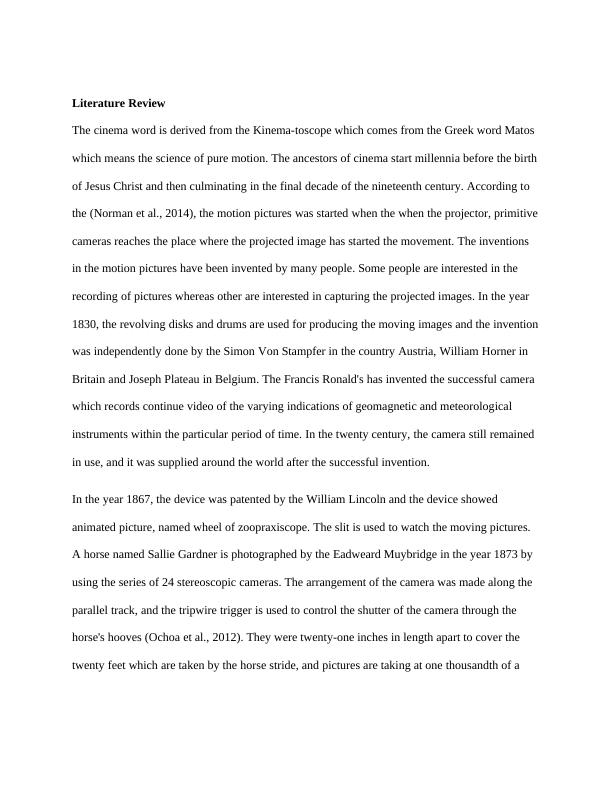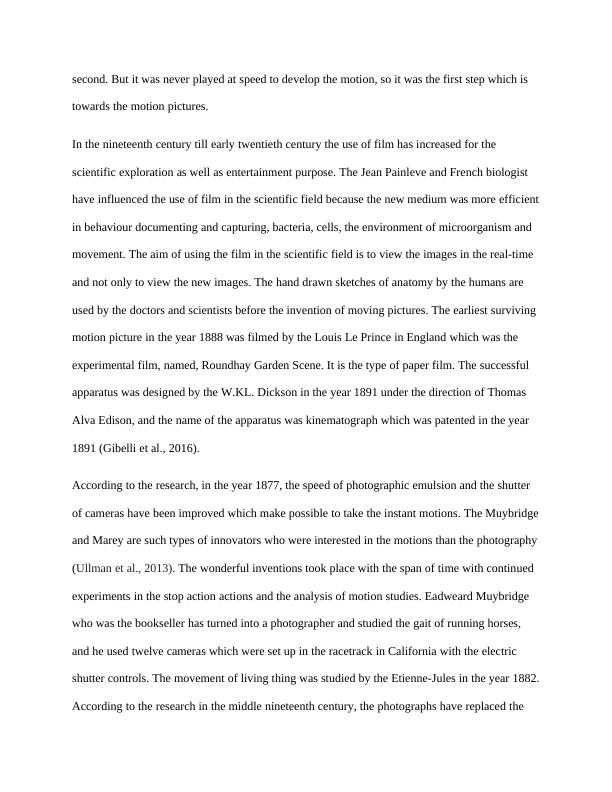Ask a question from expert
Literature Review on Cinematography
6 Pages1640 Words405 Views
Added on 2019-09-18
Literature Review on Cinematography
Added on 2019-09-18
BookmarkShareRelated Documents
Literature Review on Cinematography

Literature ReviewThe cinema word is derived from the Kinema-toscope which comes from the Greek word Matos which means the science of pure motion. The ancestors of cinema start millennia before the birthof Jesus Christ and then culminating in the final decade of the nineteenth century. According to the (Norman et al., 2014), the motion pictures was started when the when the projector, primitivecameras reaches the place where the projected image has started the movement. The inventions in the motion pictures have been invented by many people. Some people are interested in the recording of pictures whereas other are interested in capturing the projected images. In the year 1830, the revolving disks and drums are used for producing the moving images and the inventionwas independently done by the Simon Von Stampfer in the country Austria, William Horner in Britain and Joseph Plateau in Belgium. The Francis Ronald's has invented the successful camera which records continue video of the varying indications of geomagnetic and meteorological instruments within the particular period of time. In the twenty century, the camera still remained in use, and it was supplied around the world after the successful invention.In the year 1867, the device was patented by the William Lincoln and the device showed animated picture, named wheel of zoopraxiscope. The slit is used to watch the moving pictures. A horse named Sallie Gardner is photographed by the Eadweard Muybridge in the year 1873 by using the series of 24 stereoscopic cameras. The arrangement of the camera was made along the parallel track, and the tripwire trigger is used to control the shutter of the camera through the horse's hooves (Ochoa et al., 2012). They were twenty-one inches in length apart to cover the twenty feet which are taken by the horse stride, and pictures are taking at one thousandth of a

second. But it was never played at speed to develop the motion, so it was the first step which is towards the motion pictures.In the nineteenth century till early twentieth century the use of film has increased for the scientific exploration as well as entertainment purpose. The Jean Painleve and French biologist have influenced the use of film in the scientific field because the new medium was more efficientin behaviour documenting and capturing, bacteria, cells, the environment of microorganism and movement. The aim of using the film in the scientific field is to view the images in the real-time and not only to view the new images. The hand drawn sketches of anatomy by the humans are used by the doctors and scientists before the invention of moving pictures. The earliest surviving motion picture in the year 1888 was filmed by the Louis Le Prince in England which was the experimental film, named, Roundhay Garden Scene. It is the type of paper film. The successful apparatus was designed by the W.KL. Dickson in the year 1891 under the direction of Thomas Alva Edison, and the name of the apparatus was kinematograph which was patented in the year 1891 (Gibelli et al., 2016).According to the research, in the year 1877, the speed of photographic emulsion and the shutter of cameras have been improved which make possible to take the instant motions. The Muybridgeand Marey are such types of innovators who were interested in the motions than the photography(Ullman et al., 2013). The wonderful inventions took place with the span of time with continued experiments in the stop action actions and the analysis of motion studies. Eadweard Muybridge who was the bookseller has turned into a photographer and studied the gait of running horses, and he used twelve cameras which were set up in the racetrack in California with the electric shutter controls. The movement of living thing was studied by the Etienne-Jules in the year 1882.According to the research in the middle nineteenth century, the photographs have replaced the

End of preview
Want to access all the pages? Upload your documents or become a member.
Related Documents
(PDF) Cinematography and filmmaking researchlg...
|8
|2130
|84
The History of Lighting in Photographylg...
|10
|1682
|281